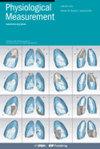Energy expenditure prediction in preschool children: a machine learning approach using accelerometry and external validation.
IF 2.7
4区 医学
Q3 BIOPHYSICS
引用次数: 0
Abstract
This study aimed to develop convolutional neural networks (CNN) models to predict the energy expenditure (EE) of children from raw accelerometer data. Additionally, this study sought to external validation of the CNN models in addition to the linear regression (LM), random forest (RF), and full connected neural network (FcNN) models published inet al (2019). Approach: Included in this study were 41 German children (3.0 to 6.99 years) for the training and internal validation who were equipped with GENEActiv, GT3X+, and activPAL accelerometers. The external validation dataset consisted of 39 Canadian children (3.0 to 5.99 years) that were equipped with OPAL, GT9X, GENEActiv, and GT3X+ accelerometers. EE was recorded simultaneously in both datasets using a portable metabolic unit. The protocols consisted of a semi-structured activities ranging from low to high intensities. The root mean square error (RMSE) values were calculated and used to evaluate model performances. Main results: 1) The CNNs outperformed the LM (13.17% to 23.81% lower mean RMSE values), FcNN (8.13% to 27.27% lower RMSE values) and the RF models (3.59% to 18.84% lower RMSE values) in the internal dataset. 2) In contrast, it was found that when applied to the external Canadian dataset, the CNN models had consistently higher RMSE values compared to the LM, FcNN, and RF. Significance: Although CNNs can enhance EE prediction accuracy, their ability to generalize to new datasets and accelerometer brands/models, is more limited compared to LM, RF, and FcNN models. .学龄前儿童能量消耗预测:利用加速度测量和外部验证的机器学习方法。
本研究旨在开发卷积神经网络(CNN)模型,从原始加速度计数据中预测儿童的能量消耗(EE)。此外,除了线性回归(LM)、随机森林(RF)和全连接神经网络(FcNN)模型之外,本研究还寻求对 CNN 模型进行外部验证。
方法:
本研究包括 41 名德国儿童(3.0 至 6.99 岁)的训练和内部验证,他们配备了 GENEActiv、GT3X+ 和 activPAL 加速计。外部验证数据集由 39 名加拿大儿童(3.0 至 5.99 岁)组成,他们配备了 OPAL、GT9X、GENEActiv 和 GT3X+ 加速计。两个数据集均使用便携式代谢装置同时记录 EE。实验方案包括强度从低到高的半结构化活动。主要结果:
1)在内部数据集中,CNN 的表现优于 LM(平均 RMSE 值降低了 13.17% 到 23.81%)、FcNN(RMSE 值降低了 8.13% 到 27.27%)和 RF 模型(RMSE 值降低了 3.59% 到 18.84%)。2)相反,当应用于加拿大外部数据集时,CNN 模型的 RMSE 值始终高于 LM、FcNN 和 RF。
本文章由计算机程序翻译,如有差异,请以英文原文为准。
求助全文
约1分钟内获得全文
求助全文
来源期刊

Physiological measurement
生物-工程:生物医学
CiteScore
5.50
自引率
9.40%
发文量
124
审稿时长
3 months
期刊介绍:
Physiological Measurement publishes papers about the quantitative assessment and visualization of physiological function in clinical research and practice, with an emphasis on the development of new methods of measurement and their validation.
Papers are published on topics including:
applied physiology in illness and health
electrical bioimpedance, optical and acoustic measurement techniques
advanced methods of time series and other data analysis
biomedical and clinical engineering
in-patient and ambulatory monitoring
point-of-care technologies
novel clinical measurements of cardiovascular, neurological, and musculoskeletal systems.
measurements in molecular, cellular and organ physiology and electrophysiology
physiological modeling and simulation
novel biomedical sensors, instruments, devices and systems
measurement standards and guidelines.
 求助内容:
求助内容: 应助结果提醒方式:
应助结果提醒方式:


